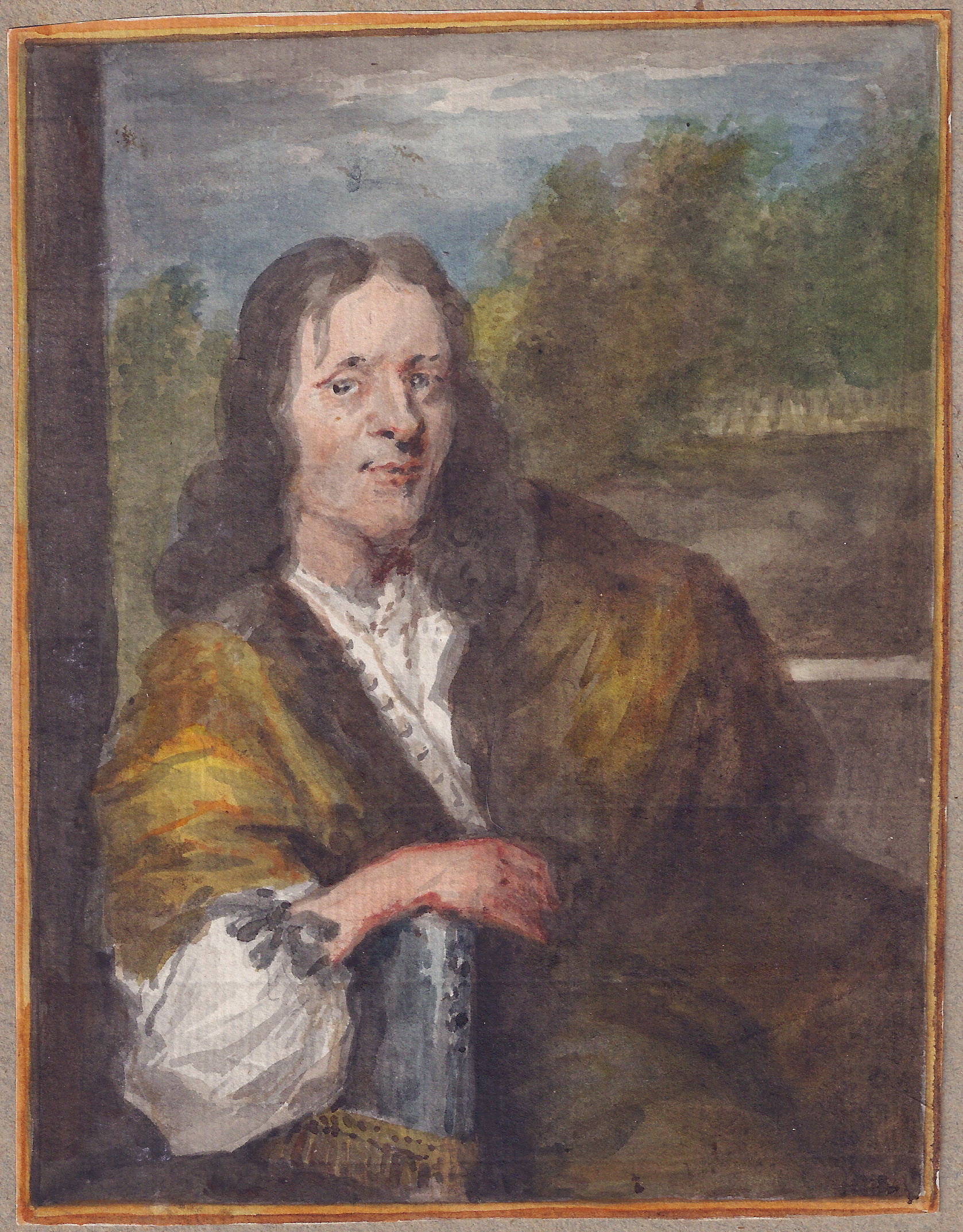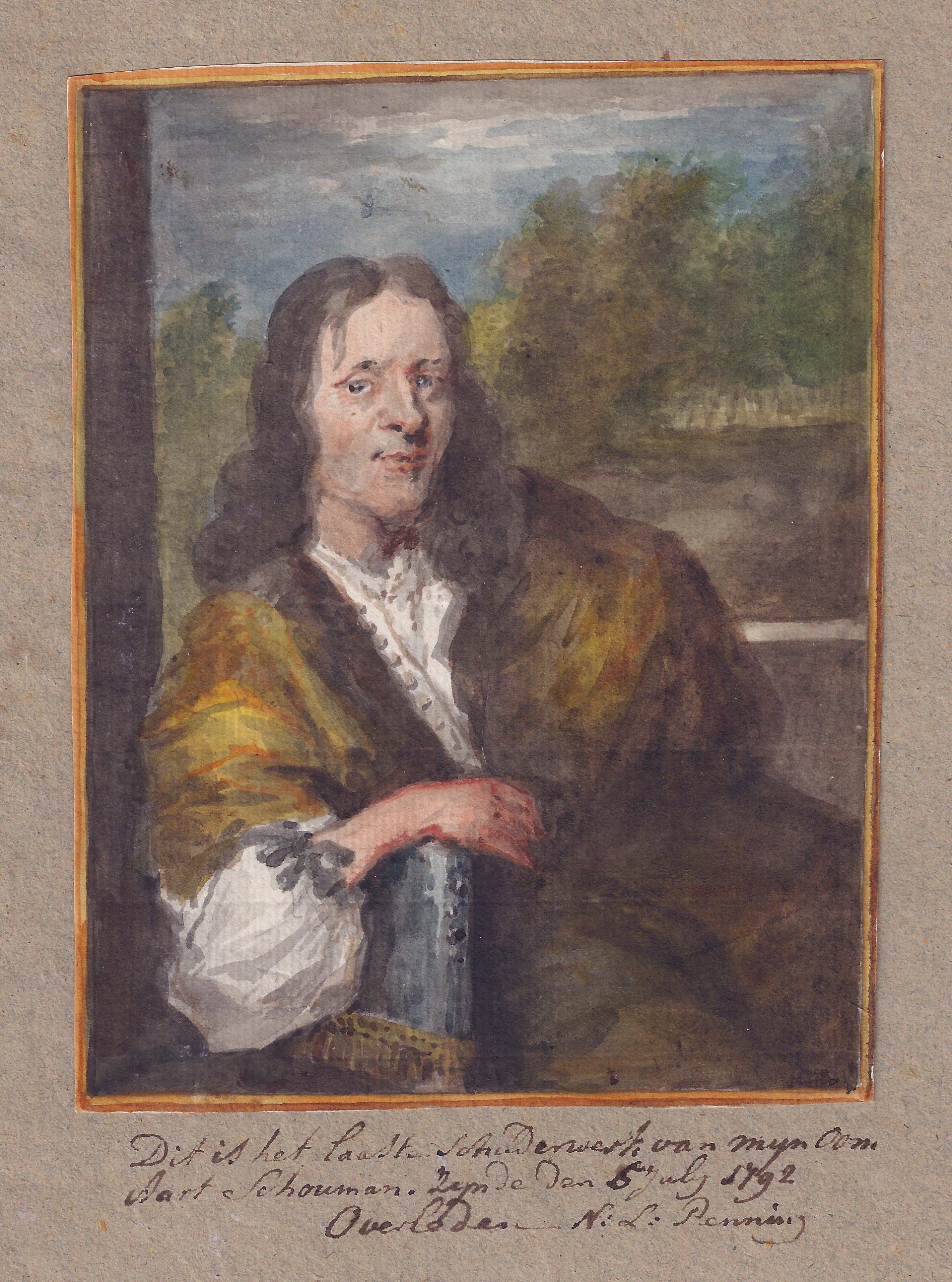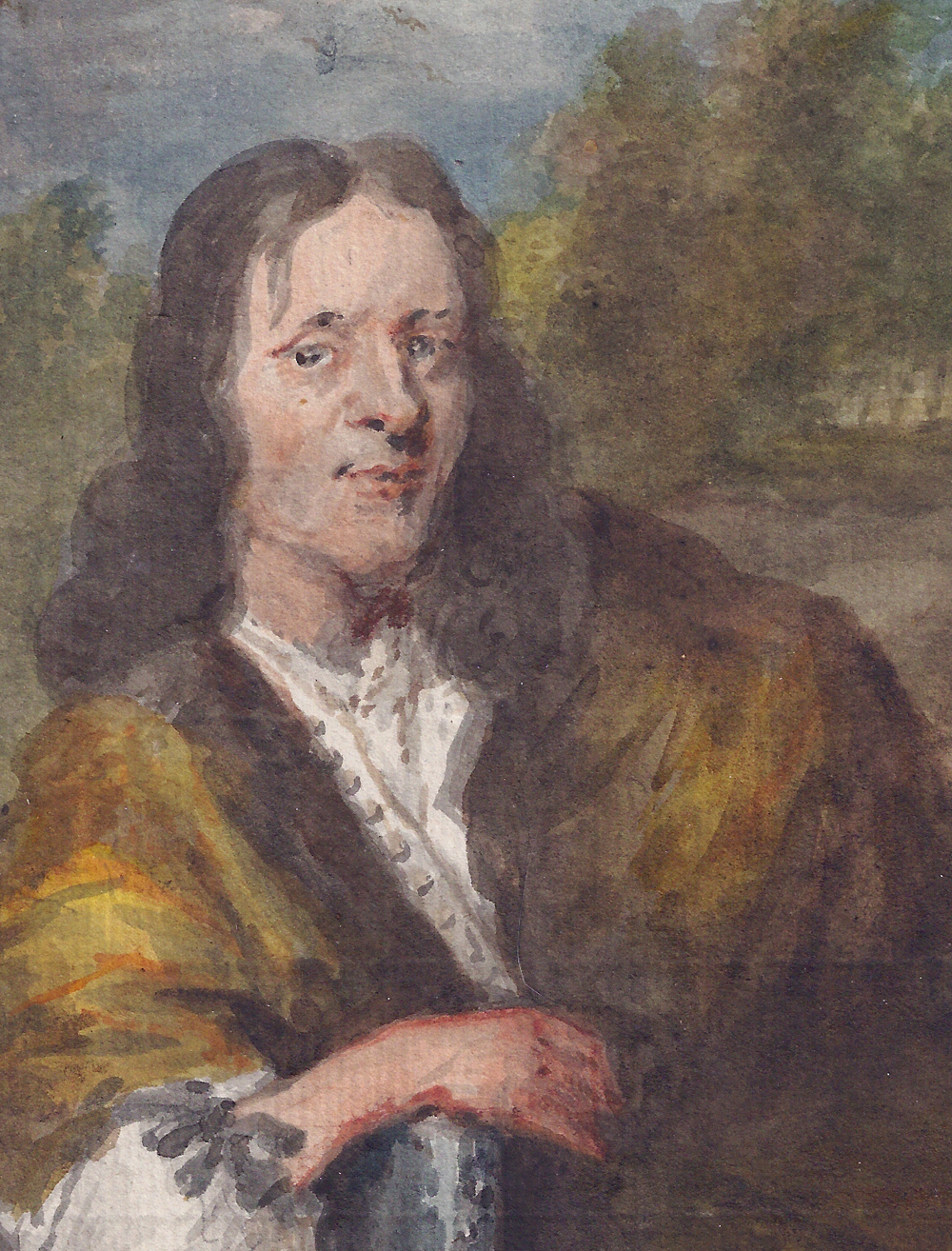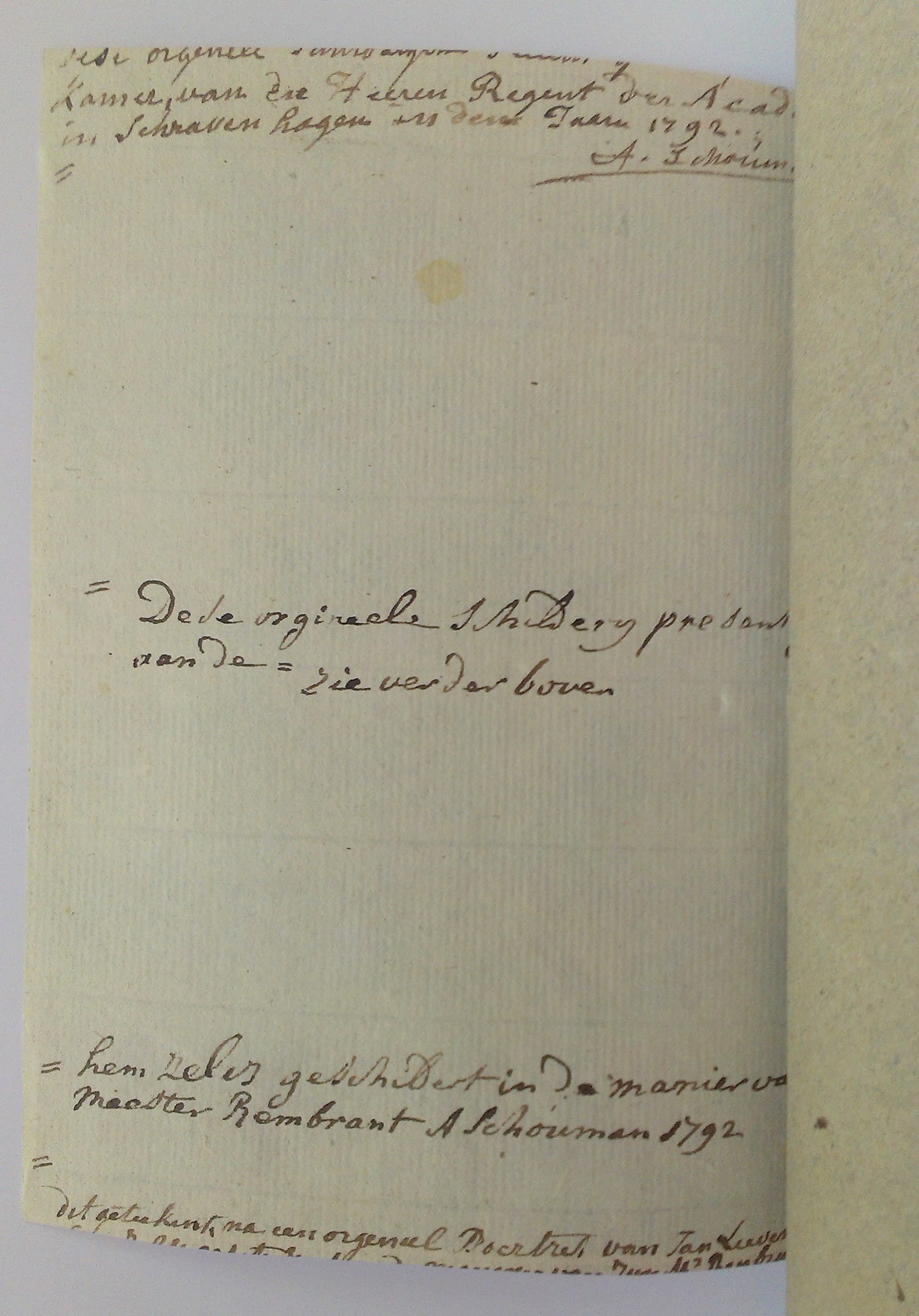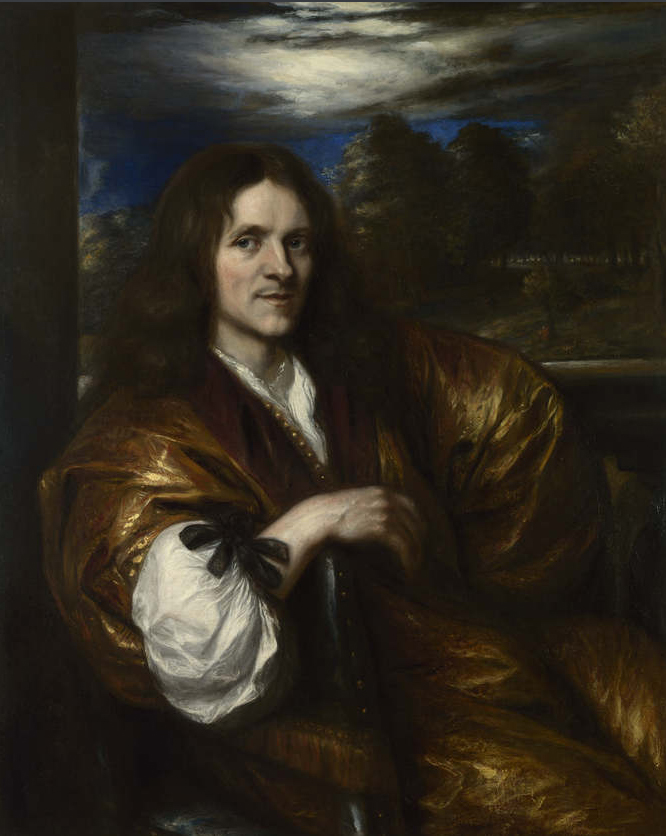AERT SCHOUMAN (Dordrecht 1710 – 1792 The Hague) after JAN LIEVENS (Leiden 1607 – 1674 Amsterdam)
Aert Schouman (Dordrecht 1710 – 1792 The Hague) after Jan Lievens (Leiden 1607 – 1674 Amsterdam)
Portrait of Jan Lievens (1607–1674)
Watercolour, graphite, yellow, orange and brown wash framing lines, 177 x 136 mm (7 x 5.4 inch)
Signed, dated and annotated: ‘= Dese orgineele schildery present / van de = zie verder boven / Kamer van de Heeren Regent der Acad. / in Schravenhagen in den Jaare 1792 / A. Schouman / dit geteekent na een orgineel Poertret van Jan Lievens / [illegible] / = hemzelve geschildert in de manier van Meester Rembrant A Schouman 1792’ (pen and brown ink, verso)1
The grey paper mount annotated ‘Dit is het laatste schilderwerk van myn Oom / Aart Schouman. Zynde den 5 July 1792 / Overleden – N:L: Penning’ (pen and brown ink)2
Provenance
- Nicolaes Lodewick Penning (1764–1818), the artist’s nephew
- Professor Johan Quirijn van Regteren Altena, Amsterdam (1899–1980), until sold by his descendants in 2015 (his collector’s mark applied on the verso of the mount)
Exhibited
Koninklijk Paradijs. Aert Schouman en de verbeelding van de natuur, Dordrecht (Dordrechts Museum) February-September 2017 (no number)
Literature
Charles Dumas (ed.), Koninklijk Paradijs. Aert Schouman en de verbeelding van de natuur, Dordrecht (Dordrechts Museum) February-September 2017, p. 288, fig. 462
***
Aert Schouman was highly productive and worked in a wide variety of media, including painting and drawing, printmaking and glass engraving.3 He was also active as an art dealer, like many of his fellow artists at the time. He trained in Dordrecht under the genre and portrait painter Adriaen van der Burgh (1693–1733), before teaching drawing in his native town, and subsequently in Middelburg and The Hague. In addition to portrait commissions, he painted decorative works such as chimneypieces and wall-hangings. He also produced a large number of watercolour drawings, including landscapes and topographical views. However it were his studies of plants and animals for which he was most celebrated. His lively watercolours of birds make him one of the greatest animaliers of the eighteenth century.
Schouman was an exceptionally accomplished watercolourist. In addition to his original watercolours he specialised in making watercolour ‘natekeningen’, copy drawings, of famous paintings from the Golden Age. These drawings, both in colour and in grey wash, were considered as works of art in their own right, in which the artist transformed oil paintings into watercolour equivalents.
Schouman’s contemporaries held his ‘natekeningen’ in such high regard that they often received even higher praise than his original works.4 In 1751, Johan van Gool praised Schouman for his ability to emulate the different styles of earlier masters: ‘die hy, in elk zynen aert en manier, zo wel weet te volgen,dat een kunstkundig oog het met den eersten opslag nauelyks kan ontwaer worden, of voor eige werk van den Meester aanziet.’5 In 1792 the collector Cornelis Ploos van Amstel (1726–1798) wrote an obituary for Schouman, in which he praised the originality and ‘gemaklyke ongedwongenheid’ of Schouman’s copies, ‘zonder slaafsche zwaarmoedigheid’, translating rather than copying his originals.6 In the words of Ploos, Schouman was able to: ‘de genie, het vuur, de kracht … uit de taal der Olywerven, in de taal der Waterverwen, heeft weeten over te brengen’.7 Schouman is even credited with having invented a special technique, halfway between watercolour and bodycolour, which enabled him to produce even more satisfying results.
In the case of this lively and exceptional portrait, Schouman chose a work from his own collection: the self-portrait of Jan Lievens (1607–1674), painted in the early 1650s, and now in the National Gallery, London (see fig.).8 Schouman may have bought the portrait at the sale of Salomon Arensklauw and Cornelis Troost, held in Amsterdam on 16 March 1750, which featured a portrait of Lievens as lot 102. On 25 April 1792, shortly before his death on 5 July of that year, Schouman bequeathed Lievens’s self-portrait to the artists’ society Confrerie Pictura in The Hague, of which he had been Dean. Schouman is likely to have made this free watercolour around the same time; it is recorded with details of the transfer to Pictura on the verso in the artist’s own hand. The watercolour passed to his nephew, the artist Nicolaes Lodewick Penning, who recorded in an intimate inscription on the mount that it was his uncle’s last ‘schilderwerk’ (painted work). Judging from the obvious quality of the watercolour, the 82-year-old Schouman was still in full command of his artistic capabilities even in the final weeks of his life.
1. ‘This original painting presented [to the] Chamber of the Lords Directors of the Academy in The Hague in the year 1792 A. Schouman. This drawn after an original portrait of Jan Lievens [illegible] painted by himself in the manner of Master Rembrandt A. Schouman 1792.’
2. ‘This is the last painted work by my uncle Aart Schouman. Having died the 5th July 1792 – N:L: Penning’.
3. For the artist, see: Charles Dumas (ed.), Koninklijk Paradijs. Aert Schouman en de verbeelding van de natuur, Dordrecht (Dordrechts Museum) February-September 2017 and L.J. Bol, Aart Schouman, Ingenious painter and draughtsman, Doornspijk 1991.
4. See Nathalie Dufais, ‘Een bijzondere opdracht: zestien kopieën in aquarel van Aert Schouman in opdracht van Cornelis Ploos van Amstel’, Bijdragen voor Rudi Ekkart bij zijn afscheid als directeur van het RKD, The Hague 2012, pp. 33-38.
5. ‘…which he, in the style and manner of each, could follow so closely, that the eye of a connoisseur could hardly grasp the difference at first glance, or would consider it the work of the master himself’, Johan van Gool, De Nieuwe Schouburg der Nederlantsche kunstschilders en schilderessen, The Hague 1751, vol. II, p. 352.
6. ‘natural ease’,‘without slavish dreariness’, Cornelis J. Cz. Ploos van Amstel, ‘Schets van het leeven en de verrichtingen van den Heere Aert Schouman, als Konstschilder Beschouwd’, Algemeene Vaderlandsche Letter-oefeningen, Amsterdam 1792, pp. 436-38.
7. ‘the genius, the fire, the power … from the language of oil painting, has been able to transfer to the language of watercolour painting.’; Ploos van Amstel, loc. cit.
8. Oil on canvas, 96.2 x 77 cm, inv. no. NG2864; A. Wheelock (ed.), Jan Lievens – a Dutch master rediscovered, exh. cat. Washington (National Gallery of Art), Milwaukee (Milwaukee Art Museum) and Amsterdam (Rembrandthuis) 2009, cat. no. 48, repr.
